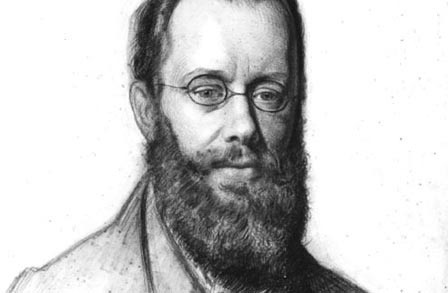Emily Dickinson- Emily Dickinson, born in Amherst, Massachusetts, on December 10, 1830, has been known as the most eccentric poet of her age. Although said to have led a life of recluse, keeping herself out of touch with from everything, she was in correspondence with many of the eminent intellectuals of her time, including Samuel Bowels and Higginson. Dickinson’s poetry are often seen through different perspectives, and this becomes possible only because of what is called the “metaphysics of absence”. While some of her poems closely reflect the influence of transcendentalism, others demonstrate the emotional condition of the poet, through the persona of the speaker. Some of the central themes found in her work include: (1) The idea of home; (2) Loss- this theme had an ubiquitous relevance in her poems, for she believed and considered loss as an inevitable part of life. (3) Isolation- a theme which she looked at through an optimistic sight. This, in her poetry, encapsulated the spiritual, physical, or psychological isolation. (4) Death- she tried to explore the nature of this ultimate truth of human being’s life through her poetic capacity.
Setting of I Like To See It Lap The Miles-
Dickinson’s poem “I Like To See It Lap The Miles” was published in 1891, and is often read in the context of the Industrial Revolution. As Harold Bloom asserts, the poet, herein, has tried to explore and examine a current technology, the railroad engine, and its effect on the landscape and agrarian lives. The poem is presented in the form of a riddle, something that was not unusual for this prolific poet, for she intended her audience to draw delight on discovering the subject through their intellectual insight. The poet escapes from providing here the adequate details about the speaker and its subject, and continues to obscure the meaning, enhancing the ambiguity through the use of metaphor; the riddle is resolved or made perspicuous only through the actions of the subject, which is addressed as “it” throughout, when the reader comes to understand that the poem is an explication of the “iron horse” of the early railway.
Poetic Devices in I Like To See It Lap The Miles-
Personification: As the first stanza begins, the reader comes to know through the description provided that the speaker is talking about some mysterious creature, something that remains unnamed to create a riddle in his mind. And the actions executed by this very creature helps in recognising its identity: it “lap the miles” and “lick the valleys up,” creating in the reader’s mind an image of an animal. Its seems to be suggestive of an animal’s swiftness. However, as the lyric develops, we discern that what is being identified or shown in the initial lines is something other than an animal, for it “stop to feed itself at tanks-/ And then-prodigious step/ Around a Pile of Mountains-/ And supercilious peer/ In Shanties- by the side of roads.” The actions now can be looked on and analysed as an extended metaphor, depicting the train as a powerful animal.
Imagery: In the third stanza, the imaginative train is being portrayed as paring a quarry in order to “fit its ribs,” which the reader might understand as its tracks. As the train, in line 13, is said to “Chase itself down Hill,” its imaginative movement is created in the reader’s mind.
Onomatopoeia: “Complaining all the while/ In horrid- hooting stanza” (Lines 10-11). This seems to be suggestive of the train’s noise and its whistle.
Allusion: “neigh like Boanerges-/ Then- punctual as a star/ Stop- docile and omnipotent/ At its own stable door”(Lines 13-16): Boanerges is a Greek word that means the “sons of thunder” and refers to the names that Jesus gave to two of his disciples: James and John. This reference might have been used by the poet to create in the reader’s mind the image of an arriving train, with its thundering cry, that reaches the station through all the ways on time, as punctual as a star.
Oxymoron: “docile and omnipotent” (Line 15)
Alliteration: “In horrid, hooting stanza” (Line 11)
Consonance: “In shanties by the sides of roads” (Line 7)
Style-
The poem “I Like To See It Lap The Miles” is a lyrical composition in four stanzas, each consisting of four lines, a quatrain as it is called.
Summary of I Like To See It Lap The Miles-
Dickinson’s “I Like To See It Lap The Miles” is a poem presented in the form of a riddle, that which is gradually deciphered by the reader as the narrative progresses. The identity of the subject, being unknown, is explicated through the actions undertaken by it; initially it is thought to be an animal, but then the quality of an industrial strength (speed and power) being portrayed by its movement instigates the reader to imagine it as a train. The speaker imagines it as going through the valleys, stopping for fuel, stepping around some mountains, passing by the human dwellings, and finally taking its final step by arriving at the station.
Critical Analysis of I Like To See It Lap The Miles-
The poem under question is one of Dickinson’s creative effort to address a new technology, a train. This machinery advancement is the direct reflection of the Industrial Revolution that was taking place during the age of Dickinson, which had an effect on the landscape, the people, including the animals. The advent of this locomotive superseded the agrarian and handicraft economy, as well as the animals that were formerly employed in various types of work. The poet, being an appreciator of the nature, might have taken this technological advancement as a devastating force, for it replaced the existing economy, undermined mankind and destroyed nature; but as the poem develops in its narrative, the reader comes along the positive points being counted by the speaker in its favour. The poem can even be understood as a way through which Dickinson tried to get out of her secluded world; and thus can be analysed in the context of her reclusiveness.
Central Idea of I Like To See It Lap The Miles-
The poem is a simple lyric that takes the technology as its central theme, thereby explicating the effects it has on the existing economy and nature.
Tone of I Like To See It Lap The Miles-
The poem begins as a riddle, taking a mysterious tone, and ends with the same. And it is the presence of ambiguity herein that engages the reader in deriving their own meaning and conclusion, depending upon their imaginative faculty.
Conclusion- “I Like To See It Lap The Miles” takes the form of a riddle, that is resolved by the intellectual capacity of the reader, keeping in mind the background of the age during which the poem was penned down. The identity of the subject that remains unidentified throughout is imagined to be a train, that has an immense power unlike animals (most probably a horse), as it is implied initially through the words like “lap” and “lick”. This new locomotive, though it was seen to have replaced the manpower and the animals like horse, has offered man new ways to explore, opening up the areas that were previously uninhabited, unexplored due to the non-availability of transportation.
Some online learning platforms provide certifications, while others are designed to simply grow your skills in your personal and professional life. Including Masterclass and Coursera, here are our recommendations for the best online learning platforms you can sign up for today.
The 7 Best Online Learning Platforms of 2022
- Best Overall: Coursera
- Best for Niche Topics: Udemy
- Best for Creative Fields: Skillshare
- Best for Celebrity Lessons: MasterClass
- Best for STEM: EdX
- Best for Career Building: Udacity
- Best for Data Learning: Pluralsight
















